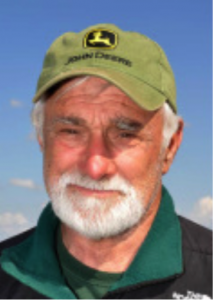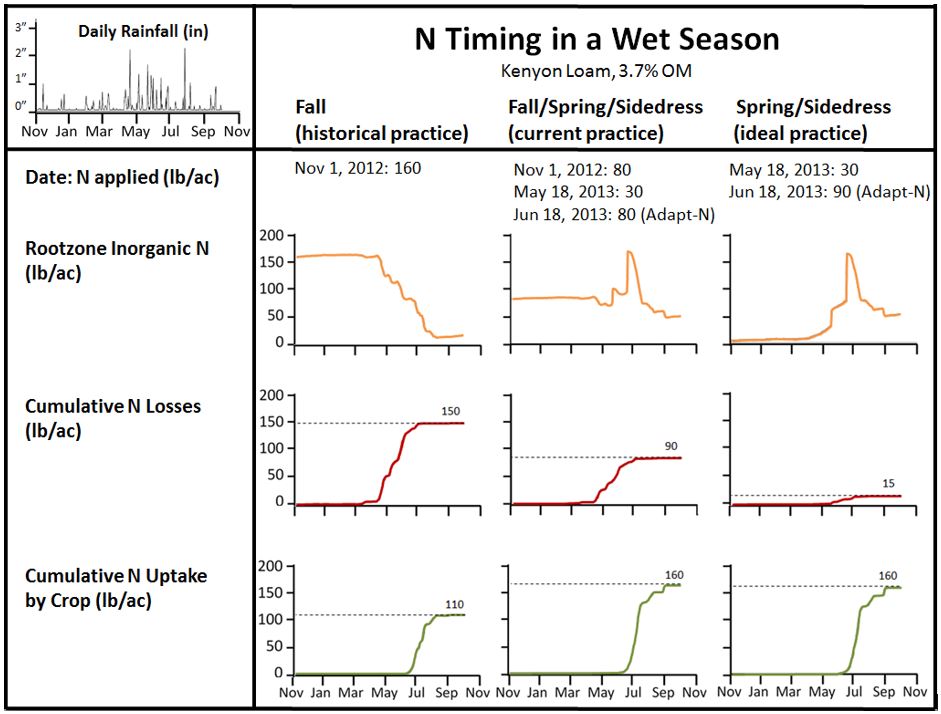Margaret Ball1, Bianca Moebius-Clune2, Shannon Gomes3, Aaron Ristow1, Harold van Es1, Soil and Crop Sciences, Cornell University1, NRCS Soil Health Division2, Cedar Basin Crop Consulting3
Shannon Gomes, owner of Cedar Basin Crop Consulting, provides services for 25 farmers in Northeast Iowa. Gomes, with his 28 years of consulting experience and a Master’s degree from Iowa State University, has extensive knowledge of Iowa soils and a particular interest in precision management. He emphasizes a scientific approach in his work, advising clients and helping them run trials to assess the many available tools and products on their farms.

Gomes has long been searching for a better way to monitor nitrogen (N) availability and provide precise N recommendations. He’s tried “all the different nitrogen management tools,” with varying results, but has never been satisfied. When he stumbled upon Adapt-N in 2009, he found what he had been looking for: a real-time, location-specific adaptive N recommendation model that accounts for weather, management practices, and field variability. Since then, Gomes’ expertise and enthusiasm have been essential in field-testing Adapt-N over three seasons and introducing the tool to Iowa. He now models all his clients’ corn acres in Adapt-N, using it as both a starting point for his N recommendations, and a teaching tool for understanding complex N dynamics. We spoke with Gomes, his colleague Frank Moore, and two farmer clients—Nick Meier and Ken Humpal—to learn how they are using Adapt-N.
The Farmers
Nick Meier
Nick farms 1200 acres on a corn-soy rotation for grain and seed production. Typical of most farmers in Iowa, he used to apply all his nitrogen in the fall, but now puts on half (80 lb/ac) in the fall, another 30 lb/ac with pre-emergence herbicide, and the remainder (about 50 lb/ac) as an early sidedress application around the V2 stage. Adapt-N simulations of each field, run by Gomes, allow Nick to adjust this final sidedress application based on the spring’s weather conditions and other field-specific factors.
Nick has completed three Adapt-N field trials. In 2012, Adapt-N recommended that he skip sidedressing altogether. There was no yield penalty, and he saved $34/ac on fertilizer and operational costs. Though waiting until sidedress sometimes makes Nick nervous, he appreciates the reduced risk of losses, and is still pushing his N applications later, as much as his comfort level will allow. In 2013, the tool warned that much of the fall-applied N had been lost to rain, and Nick should adjust his sidedress rate upward by 30 lb/ac. The higher rate yielded 14 more bu/ac and +$57/ac profit.
Ken Humpal
Ken raises dairy and beef cattle, corn (grain and silage), soy, and alfalfa on 1700 acres. Like Nick Meier, he used to apply all nitrogen in the fall, but now puts about 50% of the season’s N on as spring pre-plant (anhydrous ammonia) and the rest as sidedress. On sandier ground, he’ll skip the pre-plant altogether and wait for sidedress, because leaching risks are higher.
Ken used late spring soil nitrate tests (PSNT) in the past to determine N rates, adjusting for alfalfa and soybean credits. Now, Ken uses Adapt-N recommendations for all his acres, with minor adjustments. The tool helps account for variation in his fields due to OM content (3-5%), previous crop (corn, soy, alfalfa, or cereal rye cover crop), manure history, and soil type influences. It also helps him track the retention or loss of nitrogen from manure applications, for purposes of nutrient management planning and regulation compliance. Ken completed one Adapt-N field trial in 2011. In this instance, the tool recommended he apply 30 lb N/ac above his usual practice, and the higher rate was justified by a 6 bu/ac higher yield and +$13/ac profit.
Frank Moore
Frank is a consultant colleague of Gomes and a farmer himself. He grows corn and soy on 2000 acres, and develops nutrient management plans for his clients through Three Rivers Ag Consulting. Unlike many Iowa farmers, Frank does not apply N in the fall or at planting but rather applies only 30 lb N/ac with pre-emergence herbicide. The rest of the season’s N is added at sidedress, using Adapt-N-recommended rates. His sidedressing equipment can be driven in corn up to about 18” tall without damaging it, even at this stage. It takes Frank about 5 days to sidedress 1000 acres of corn, but he’s never been rained out. Sidedressing does cost slightly more for the extra trip, Frank says, but it is worth the minimized risk of N losses, and the ability to reduce total N applied in dry years.
Before Adapt-N, Frank applied all N with his pre-emergence herbicide. This system “works about 3 out of 5 years”, he says, but not when you have excessive rain. Using Adapt-N hasn’t greatly changed Moore’s N rates overall, but it has helped him shift more N from spring to sidedress, and adjust for weather. He applied less than normal across his farm in 2012, and more in the wet season of 2013. In addition, Frank completed six trials of Adapt-N on his fields and on average, Adapt-N reduced N rates by 22 lb/ac resulting in insignificant yield and profit changes. Frank says the biggest savings from his N program have come in extreme circumstances. In 2013, when spring weather prevented planting in many fields, Moore estimates he saved $35,000 by avoiding putting N on early!
Using Adapt-N
“When you compare [Adapt-N] to other tools… nothing even comes close,” says Gomes, “and I’ve used all of them!” In a normal weather year, Gomes and his farmers observe that Adapt-N recommends N rates similar to what they would use otherwise. However, the tool is particularly useful in accounting for contrasting weather scenarios. For instance, in the very dry 2012 versus the very wet 2013 springs, Adapt-N helped Gomes “stay ahead of the curve” – recognizing and correcting N shortage in a field before the crop showed signs of deficiency. Adapt-N has allowed growers to reduce N applications by 29 lb/ac on average with no yield penalty, resulting in average savings of $17/ac.
The tool is convenient—it achieves field- and sub-field-level precision without the large sampling effort associated with in-season field-measurements. Before using Adapt-N, Gomes based N recommendations on PSNT samples from a few thousand acres per year. Although many samples can be taken, it’s hard to be sure they are representative. When it rained after sampling, he had to go out and re-sample, or assume that test results were no longer useful. Gomes and Ken Humpal agree they can now monitor soil N availability through Adapt-N – its previous-day high resolution precipitation data gives the closest thing to real-time N measurements, and doesn’t require in-season waiting on the results of lab tests. “I think [Adapt-N] is the thing!” Ken says. Within 24 hours of a rainfall event “you know what you’ve got out there.”
The model provides graphs of available soil N, N uptake and losses, rainfall, temperature, and other factors that are extremely useful as teaching tools, understanding recommendations, and for scenario testing through retrospective runs. For example, from the wet season of 2013 we can see Adapt-N’s “what-if” N timing simulations comparing standard management, Nick Meier’s actual management, and the Adapt-N recommendation (Figure 1; sidebox). This can help a farmer re-examine previous N management programs, and consider the effects of new programs before actually putting them into practice. “The most powerful part of the interface is the graphs,” says Gomes. “You can sit down with a farmer and show them what’s really happening.”

Future Directions

Gomes is proud that he has persuaded most of his clients to move away from fall N application—a project he’s been working on for quite a while. Now that he uses Adapt-N for recommendations on all client acres, he is able to offer even more incentive to plan on sidedressing, using more precise rates adjusted in season.
Shifting toward sidedress is not without its concerns. Nick and Ken worry about getting rained out and missing the critical window to fertilize, or damaging young corn. Ken remains confident however that sidedressing risks and costs are justified by the additional savings he found during three years of field trials. “I’m excited about Adapt-N,” he says “it’s just a matter of fitting it into the system…” Frank Moore has found great benefit in sidedressing, and risks of rain-out or damage to corn have not caused him problems in his many years using this system. As high-clearance equipment, RTK/GPS, and variable rate technology are becoming more common among growers and custom applicators, the incentives for sidedressing are starting to clearly outweigh the challenges.
What is on Shannon Gomes’ mind for the future? He is strongly interested in soil health testing and helping his clients improve their soil management. Soil health and nitrogen management are closely connected (Figure 2), and Gomes is looking at cover crop and tillage system impacts on soil health and nitrogen dynamics. This way, his farmers can reap the benefits from improved soil health through increased yields and higher N availability, as estimated by Adapt-N.


